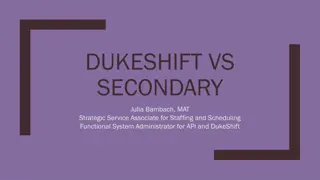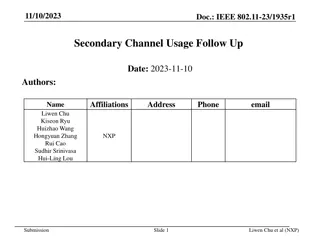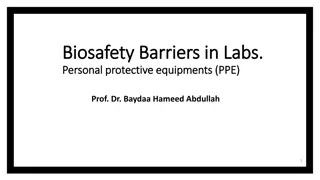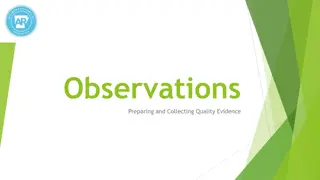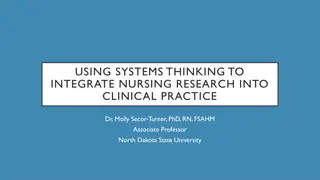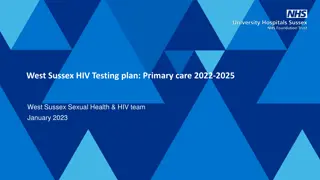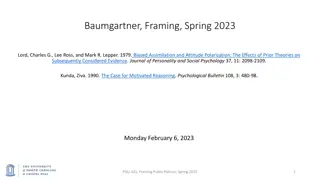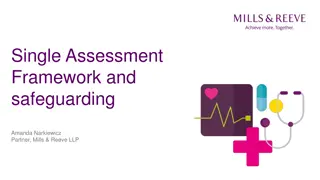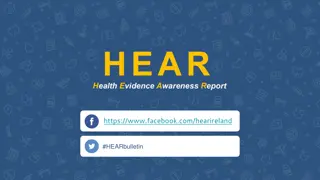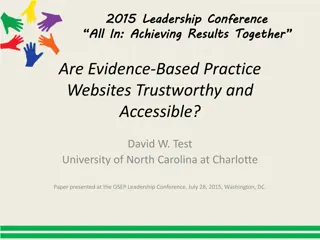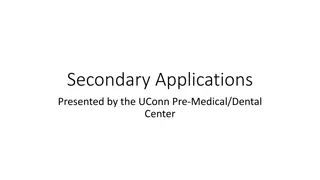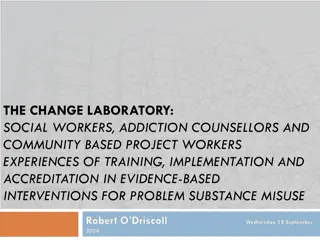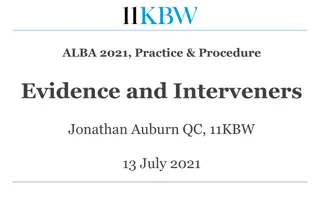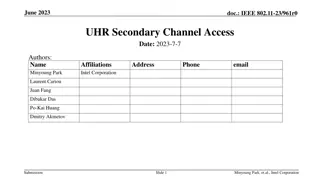Implementing Evidence-Based Practices in Secondary Settings
Explore the relationship between RTI, evidence-based practices, and high leverage practices in secondary education. Understand the importance of implementing EBPs and HLPs across prevention tiers. Discover the key objectives and considerations for applying these practices effectively.
Download Presentation

Please find below an Image/Link to download the presentation.
The content on the website is provided AS IS for your information and personal use only. It may not be sold, licensed, or shared on other websites without obtaining consent from the author.If you encounter any issues during the download, it is possible that the publisher has removed the file from their server.
You are allowed to download the files provided on this website for personal or commercial use, subject to the condition that they are used lawfully. All files are the property of their respective owners.
The content on the website is provided AS IS for your information and personal use only. It may not be sold, licensed, or shared on other websites without obtaining consent from the author.
E N D
Presentation Transcript
Module 13 Evidence-Based Practices Across the Tiers in Secondary Settings
Secondary RTI Series Overview Module 11: Overview of Secondary RTI Implementation Module 12: Early Warning Systems in Secondary Settings Module 13: Evidence-Based Practices Across the Tiers in Secondary Settings 2
Module 13 Objectives Participants will be able to: Define and explain the relationship among RTI, evidence-based practices (EBPs), and high leverage practices (HLPs). Support implementation of EBPs and HLPs across the tiers of prevention within a secondary multi-tiered system of support. 3
THINK-PAIR-SHARE What comes to mind when you think of evidence-based practices, or EBPs? What would you like to learn more about in regard to EBPs in secondary settings? Discuss 4
Response to Intervention RTI integrates assessment and intervention within a schoolwide, multilevel prevention system (i.e., multi-tiered system of support, or MTSS) to maximize student achievement and reduce behavior problems. RTI is not a special education initiative; it is an educational initiative for all students, including those at risk, students with language differences, and students with disabilities. Source: National Center on Response to Intervention. 6
RTI Focus Area for Secondary Setting Elementary RTI models are NOT considered appropriate for secondary schools. Before implementing RTI in secondary settings, teams must determine the focus of implementing an RTI model. If prevention, which negative consequences will be the focus of the prevention efforts? If proficiency, what areas move students toward proficiency? 7
RTI at All Grade Levels Focus Outcomes Prevention of poor learning outcomes Schoolwide, early intervention Improvement in basic literacy and math skills Appropriate identification of at-risk students Elementary School Dropout prevention Prevent poor learning outcomes in HS Prepared for HS success Credits/Proficiency on state exams Middle School Dropout prevention Supplemental intensive support Content recovery Targeted grades/populations Improve graduation rate Pass core courses/exams High School 8
Across the Tiers Tier I Tier II Tier III Comprehensive, research-based curriculum and differentiated based on students needs Supplemental, evidence-based interventions; supports core instruction Supplemental, customized, intensive, systematic, evidence- based instruction that targets areas of greatest need; supplements core instruction Instruction/ Intervention Approach Whole group with flexible grouping Small, homogeneous grouping (1:3-1:5) Small, homogeneous grouping (1:1-1:3) Group Size Screening, 3 times yearly All students Biweekly Weekly Assessment Students identified as at risk (10% 15%) Significant and persistent learning needs, nonresponders (1% 5%) Population Served 9
Varying Evidence Standards Research-Based Evidence-Based Recommended for Tier I across subjects Components have been researched and found to be generally effective Curriculum materials have not been rigorously evaluated as a package Recommended for Tier 2 and Tier 3 Materials evaluated using rigorous research design Evidence of positive effects for students who received the intervention 10
Interventions Within an RTI Framework Using interventions that have a proven track record increases the probability of positive outcomes for students. Interventions Must Be Evidence- Based (Brown-Chidsey & Steege, 2005, p. 8) 11
Introduction to High Leverage Practices and Evidence-Based Practices 12
Guiding Questions What are evidence-based practices and high leverage practices within RTI? What is the relationship among the three terms? 13
High Leverage Practices A set of practices that are fundamental to support student learning, and that can be taught, learned, and implemented by those entering the profession. (Windschitl, Thompson, Braaten, & Stroupe, 2012, p. 880) HLPs are HOW teachers deliver instruction. All teachers should have deep knowledge in a core set of effective instructional practices. (McLeskey & Brownell, 2015) 14
High Leverage Practices HLPs are applicable to the everyday work of teachers Fundamental to effective teaching across the tiers Cut across content domains and grade levels Supported by research Used frequently 15
High Leverage Practices Accelerate Student Achievement High Leverage Practice Effective Size if Used With Fidelity Explicit Instruction 0.57 Scaffolded Supports 0.58 Identify and Prioritizing Learning Goals 0.51-0.59 Feedback 0.66 Response to Intervention 1.09 Strategies to Promote Active Student Engagement Teaching Cognitive and Metacognitive Strategies 0.40-1.20 0.55-1.29 17
High Leverage Practices Expert Activity Read about the assigned high-leverage practice(s). Prepare two to three key points and an implementation consideration related to your HLP(s) to share with the larger group. Activity Workbook 18
What are Evidenced-Based Practices? EBPs are taught using HLPs! Developmentally appropriate Are content specific Learner dependent Supported by research 19
HLPs and EBPs: A Promising Pair Activity Workbook 20
Across the Tiers Tier I Tier II Tier III Comprehensive, research-based curriculum and differentiated based on students needs Supplemental, evidence-based interventions; supports core instruction Supplemental, customized, intensive, systematic, evidence- based instruction that targets areas of greatest need; supplements core instruction Instruction/ Intervention Approach Whole group with flexible grouping Small, homogeneous grouping (1:3-1:5) Small, homogeneous grouping (1:1-1:3) Group Size Screening, 3 times yearly All students Biweekly Weekly Assessment Students identified as at risk (10% 15%) Significant and persistent learning needs, nonresponders (1% 5%) Population Served Discuss 21
Multi-Tiered System of Supports: Core Instruction 22
Why Do We Need a Prevention Framework? Early Elementary K 3 Upper Grades 4 9 Student Outcome No. of Effects Mean ES Mean ES No. of Effects .46 25 .09 37 Comprehension .34 11 .12 8 Reading Fluency .56 53 .20 22 Word Reading .40 24 .20 5 Spelling Wanzek et al., 2013 23
Purpose of Tier 1 Core Instruction Serves as the foundation of the RTI framework Meets the needs of ALL students Provides ALL students will high quality instruction Increases access to quality Tier I instruction through differentiated instruction Core instruction is the first line of defense against academic failure. 26
Tier I Characteristics The focus is on prevention for all students. 27
Tier I Critical Features Design Delivery Uses research-based curriculum materials Articulation of teaching and learning (in and across grade levels) Curriculum aligned to state standards Schedule Evidence-based practices and high leverage practices Consistent use of differentiated instruction Inclusion of students with disabilities and those exceeding benchmark 28
Poor Quality of Tier 1 Impact Increase in the number of students in intervention Decrease in impact of interventions and instruction Fuchs & Fuchs, 2017 Discuss 29
Indicators of Tier 1 Concerns Less than 80% of students are identified as at or above grade level expectations or identified measures Inconsistent performance across classrooms, grades, or schools Poor attendance, low student engagement, and/or frequent behavior problems High rates of students (>20%) identified for supplemental support Differential benefit across student populations Low teacher satisfaction or engagement 30
Key Characteristics of High Quality Tier 1 Instruction Consistent opportunities to work on grade-appropriate assignments Strong core instruction where students do most of the thinking in a lesson Deep engagement in what students are learning Teachers who hold high expectations for students and believe they can meet grade level standards TNTP, Inc. 2018 31
Effective Instruction It is imperative to equip teachers with a set of practices that are supported by research evidence to have significant potential for improving academic or behavioral outcomes for students with disabilities. High Leverage Practices for Inclusive Classroom, CEC 2019. 32
High Leverage Practices Set of practices that: Support student learning Can be taught, learned, and implemented Applicable to the everyday work of teachers: Used in classrooms to leverage and improve student outcomes Used frequently by teachers Broadly applicable across content areas Fundamental to effective teaching 33
Tier 1 Adolescent Literacy Practices Recommendations Provide explicit vocabulary instruction. # 1 Evidence Strong 2 Provide direct and explicit comprehension strategy instruction. Strong 3 Provide opportunities for extended discussion of text meaning and interpretation. Moderate 4 Increase student motivation and engagement in literacy learning. Moderate 34
Tier 1: 4th-8thMath Instructional Practices Recommendations # Evidence 1 Prepare problems and use them in whole-class instruction. Minimal 2 Assist students in monitoring and reflecting on the problem-solving process. Strong 3 Teach students how to use visual representations. Strong 4 Expose students to multiple problem-solving strategies. Moderate 5 Help students recognize and articulate mathematical concepts and notation. Moderate (Woodward, Beckmann, Driscoll, et al., 2018) 35
Secondary Core Tier 1 EBPs: School Completion # Recommendations 1 Monitor the progress of all students, and proactively intervene when students show early signs of attendance, behavior, or academic problems. 2 Provide intensive, individualized support to students who have fallen off track and face significant challenges to success. Evidence Minimal Moderate 3 Engage students by offering curricula and programs that connect schoolwork with college and career success and that improve students capacity to manage challenges in and out of school. For schools with many at-risk students, create small, personalized communities to facilitate monitoring and support. Strong 4 Moderate (Rumberger, R., Addis, H., Allensworth, E., et al., 2017). 36
Identifying Tier 1 Evidence-Based Practices 37
Tier I: Self-Evaluation Activity Workbook 38
Multi-Tiered System of Supports: Supplemental and Intensive Intervention 39
Supplemental and Intensive Instruction Focus Students identified through screening as at risk for poor learning outcomes; verified by progress monitoring or other data Typically, 15 percent to 20 percent of entire school population At the high school level, a problem-solving approach should be used if the failure rate in any course, especially core courses, is greater than 10 percent 40
Tier II Supplemental Intervention GROUPING/ SETTING FOCUS INTERVENTIONIST CURRICULUM What instructional materials are used? Who receives instruction? Who provides instruction? How is instruction delivered? Students not adequately responding to Tier 1: core instruction General education teacher or other trained professional Evidence- based tools that address identified area(s) of need In small groups of 3 5 studentsa In targeted, homogenous groups determined by skill Note. All interventions should be delivered with adherence to program developer guidelines. aAlthough research recommends small groups of 3 5 students, the intervention program should dictate the group size. 41
Four Critical Features of Tier 2 1. Uses evidence-based interventions that support academic and behavior needs 2. Complements core instruction/program 3. Uses standardized interventions with appropriate dosage and grouping size delivered by trained personnel with fidelity 4. Scheduled in addition to Tier 1 42
Tier 3: Intensive Intervention Intensive intervention is designed to address severe and persistent learning or behavioral difficulties Driven by data Characterized by increased intensity (e.g., smaller group, expanded time) Provided with individualized academic instruction and/or behavioral supports 43
Who Needs Intensive Intervention? Students with very low academic achievement and/or high-intensity or high-frequency behavior problems (may be with disabilities) Students in a tiered intervention program who have not responded to Tier 2 intervention(s) delivered with fidelity Students with disabilities who are not making adequate progress in their current instructional program 44
Essential Tier 3 Criteria More intensive than Tier 2 intervention(s) Adapted to address individual student needs in a number of ways (e.g., increased duration or frequency, change in interventionist, decreased group size, change in instructional delivery, and change in type of intervention) A consistent process based on student data 45
Essential Tier 3 Criteria Led by well-trained staff, experienced in individualizing instruction based on student data Students can be identified for Tier 3 supports either through universal screeners or nonresponse to an evidence-based intervention The advantage of using a universal screener is that students do not have to wait to fail at Tiers 1 and 2 46
Key Considerations: Evidence- Based Interventions Does evidence suggest the intervention is expected to lead to improved outcomes (strength)? Will the group size, duration, and frequency provide sufficient opportunities to respond (dosage)? Does the intervention match to the student s identified needs (alignment)? Does it assist the student in generalizing the learned skills to general education or other tasks (attention to transfer)? 47
Key Considerations: Evidence- Based Interventions Does the intervention include elements of explicit instruction (comprehensiveness)? Does the student have opportunities to develop the behavior skills necessary to be successful (behavioral support)? 48
Fidelity & Your RTI Framework Multi-Tiered System of Supports Data-Based Decision Making Screening/ Diagnostic/ Progress Monitoring Formative/ Summative Assessment 50 National Center on Response to Intervention, 2012




